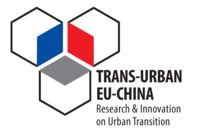
TRANS-URBAN-EU-CHINA
Transition towards urban sustainability through socially integrative cities in the EU and in China
Living Lab Approach
1. Purpose(s)
The Living Lab approach provides a framework for co-creation, testing and validation of solutions by involving, mobilizing and including citizens or any other groups of actors, stakeholders and experts. The aim of Living Labs is to develop innovative solutions in a real-living environment and a collaborative well moderated setting.
Key Words: living lab; real-living environment; collaboration; stakeholders
2. Relevance and Impact
Co-created and validated solutions that have a higher potential of being implemented and locally anchored than solutions without a common test phase. Through the Living Lab approach solutions are more sustainable because the needs of the population have been considered. The testing phase, but also the common exchange, has removed doubts and uncertainties related to this ‘new’ implemented solutions. This low-threshold approach of the Living Labs leads to the integration of different groups of the population, which would not be reached with traditional approaches.
In the case study cities, the Living Lab approach is used in European and Chinese context (Santander, Vienna and Suzhou). Europe cities use the Living Lab approach for renewable areas as well as for new urban development projects. Living Lab cases in China mostly appear in large cities with a higher level of openness and are generally initiated by agencies such as urban planning institutes, universities, and research institutions. Significant progress has been achieved in the fields of place-making of historic and cultural blocks. The tool was tested in an online workshop in August 2020 with Chinese experts. They confirmed that a change in planning tools is needed, where the focus is more on the outcome, the quality and the people. The Living Lab approach is very promising and useful for neighborhood planning because by involving citizens, the goals are far clearer. The acceptance is greater due to the participation, the places are more livable, and the planning is more sustainable, inclusive and it creates better cities for all.
3. Strenghts
Working closely together with the ‘users’ of intended solutions enables an immediate reality check. A Living Lab setting allows to access locally embedded knowledge, competences and to build on the diverse types of community-intelligence. The flexibility and robustness of the conceptual solutions are tested in the process and the limitations as well as potentials can be exposed and framed early on.
4. Weaknesses
A Living Lab approach requires a highly transparent, well guided and moderated process. The quality of the solution depends on the involved participants, their motivation, agenda and mindsets.
5. Good practice examples
Santander (map): Urban Laboratory
Santander Urban Laboratory is a laboratory for testing technology. Santander Living Lab setting provides a physical room that accommodates companies and different stakeholders interested in testing new technologies and services and exchanging amongst each other. By doing so, respective companies and stakeholders may enrich the assets of the city. Close collaboration with universities and other research institutions is essential in this context.
Vienna (map): Seestadt Aspern
The Aspern Seestadt Citylab was established in a new urban development project in Seestadt Aspern, Vienna. It is a modular, interdisciplinary dialogue-platform and space dedicated to developing, discussing and promoting progressive solutions, based on the exchange between different stakeholders. The Citylab participants work on concrete questions related to the planning processes, such as investigating the framework conditions and instruments for the development of different types of spaces. Interested individuals and experts are openly invited to engage in the discussion and co-creation. The outcomes generated in the CityLab serve the specification and fine tuning of urban development strategies and measures.
6. References
Santander:
Urban Technology Alliance (UTA): https://www.urbantechnologyalliance.org/portfolio/santander-spain/
Information on the Santander City Lab by one of the project partners (Ferrovial Services): https://www.ferrovialservicios.com/en/project/data-analytics-in-urban-services-santander-city-lab/
Vienna:
Aspern MobilLab - Participation of citizens: https://www.mobillab.wien/pop-up-lab/
Strategic document: https://www.aspern-seestadt.at/jart/prj3/aspern/data/downloads/2011-citylab-report-2-2-die-instrumente-des-staedtebaus_2017-07-10_1607746.pdf p. 124-126
7. Author(s) of the article
Gudrun Haindlmaier, Hans-Martin Neumann


